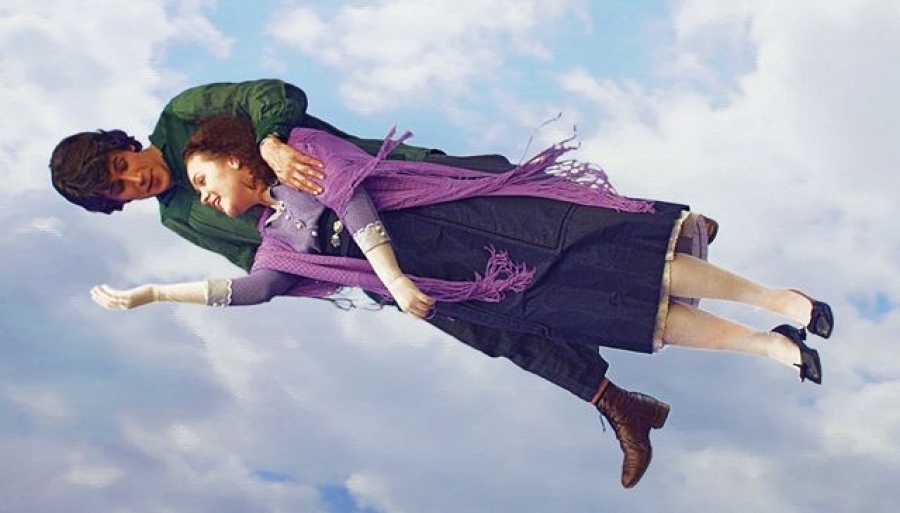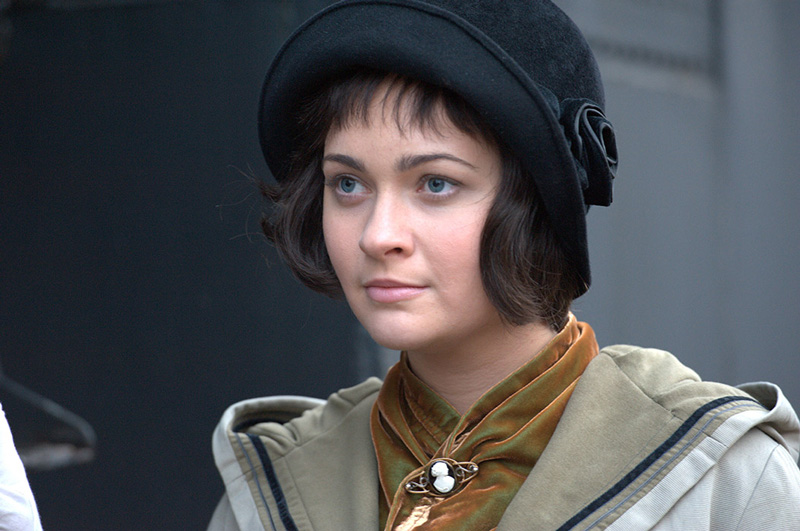[:en]
Austrian actress Kristii Schneider describes Marc Chagall’s art as “mystical” — the same word she uses about her having landed one of the lead roles in Russian director Alexander Mitta’s new film, “Chagall-Malevich,” about the early modernist Chagall and his founding of the Vitebsk Arts College in the early days of the Russian Revolution.
Schneidermann was cast as Bella Rosenfeld, Chagall’s first wife and only true love and muse. It’s a part she feels she was destined to play.
“It turns out that I look very much like Bella did when she was a young woman, and I share my birthday with Chagall. There’s something mystical about that, I think,” Schneidermann recently told The Times of Israel in a phone conversation.
Even Chagall’s granddaughter Meret Meyer Graber (a member of Comite Chagall, the group that passes judgment on the authenticity of works attributed to the artist) was struck by the 24-year-old Schneiderman’s strong resemblance to Bella when members of the Russian-language film’s cast came to visit her in her Paris home, the very same one in which her grandparents lived in many decades earlier.

Kristii Schneider as Bella Rosenfeld Chagall in ‘Chagall-Malevich.’ (Courtesy of ShiM-Film Pictures)
“She called me ‘Grandma Bella’ and was very touched when I sang to her the lullaby that I sing to my character’s daughter [Graber’s mother Ida] in the film. It was the same song that her grandmother used to sing to her when she was little girl,” the actress said.
“Chagall-Malevich” draws viewers into Chagall’s world and artistic imagination during the period of 1917-1920, when the October Revolution and then the Russian Civil War prevented him from returning to Paris, where he had been studying art prior to World War I. He had returned to his hometown of Vitebsk (in Belarus today) to marry his childhood sweetheart Bella, and became trapped in Russia with the outbreak of the war. The couple at first moved to Moscow, but soon decided to return to Vitebsk, where Chagall was appointed the regional comissar of arts.
The dramatic tension in the film arises from Chagall having invited Kazimir Malevich, the founder of the Suprematism, an art movement focusing on basic geometric shapes such as squares, circles and lines painted in limited colors, to teach at the art college. While the two members of the modernist avant-garde respected one another, they and their student-followers clashed over the difference in their artistic approaches. Eventually, with many of the teachers and students siding with the more radical Malevich, Chagall left for Moscow. (The film ends here and does not deal with how in 1923 the Chagalls moved to France, where they lived until escaping Nazi occupation to the US in 1941. Chagall lived in the US until 1948, but Bella died there in 1944. The artist moved back to France, where he lived until his death in 1985 at age 97.)

Anatoliy Beliy (center) as artist Kazimir Malevich in ‘Chagall-Malevich.’ (Courtesy of ShiM-Film Pictures)
The fictional feature film’s plot is based on actual events, save for a love triangle Mitta fabricated between Chagall (played by Leonid Bichevin), Bella and a childhood friend named Naum, a dreamy poet turned Red Commisar (Semeon Shkalikov), who did not exist in real life. Mitta added in this romantic tension (mainly Naum’s pining for Bella, who is wholly devoted to her husband) to amp up the emotional tension—already high due to the artistic conflict between Chagall and Malevich set against the backdrop of the increasingly violent revolution.
“All characters of the film convey different ideas. Chagall symbolizes one idea. Malevich, another one. My film represents the struggle of these ideas in a tangle of emotions and desires at the moment when life is worth nothing and art means everything,‟ said Mitta in his director’s statement.
While the film’s intentions are noble, the bombastic dialogue has characters spewing ideological polemics rather than having normal conversations, making for some trying moments. It is far more gratifying to focus on the film’s stunning visuals, which make a viewer feel as though she’s suddenly been dropped inside of Chagall’s paintings. It is this magical realism, with colors practically popping off the screen and characters gently floating up into the sky, that turns “Chagall-Malevich” into a virtual cinematic folktale.
Schneidermann was impressed by this aspect of the film, and particularly by the Chagall-style shtetl set built in Vitebsk especially for the film shoot. (The city asked that the set remain, and it is now serving as a Chagall museum). The actress also noted the the extreme attention to detail paid by the costumer in recreating the exact items of clothing based on their appearance in Chagall’s paintings. In this sense, viewing the film is akin to watching Chagall’s art come to life.
Schneidermann, who grew up in a Jewish family in Vienna, has visited friends and family in Israel many times. She’s used to flying, be it to Tel Aviv or between Moscow and London, where she attended two different drama schools concurrently. In the last year she’s racked up countless frequent flier miles traveling to 20 different film festivals around the world for screenings of “Chagall-Malevich.”
“That’s another way in which I am like the character I play in the film. We both fly a lot,” she said of Bella, who soars in the arms of her artist husband above Vitebsk in “Over the Town,” her favorite of Chagall’s paintings.
— Renee Ghert-Zand, Times of Israel.
Chagall-Malevich official page.
[:]
